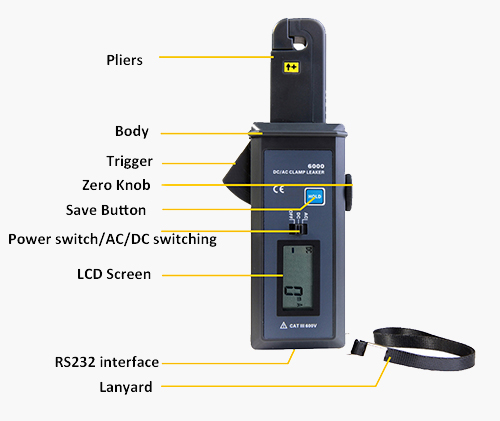The earth leakage clamp meter can accurately test leakage current with a measurement range from 0mA to 60A. The leakage current clamp meters help users detect, document, record and compare leakage current readings over time as a means of preventing unplanned downtime.

AC/DC leakage current clamp meter with the measuring range of 0mA-60A.
- The iron core is made with high-performance permalloy, hall induction technology, which is suitable for the electric power measurement systems, high-speed railway systems and automobile circuit maintenance, etc.
- Meter small size, high precision, stable performance.
- Data hold and data storage functions. Data upload function, the storage data can be uploaded to the computer, convenient to read, save and print and so on.
Applications
sisco clamp current meter is available with a measuring range of 0mA-60A AC/DC. The clamp ammeter is especially suitable for places with dense wiring (power metering systems, high-speed rail systems, automotive circuit maintenance, etc.), and non-contact current measurements to ensure safe operation. The instrument is small in size, high in precision, stable in performance and perfect in function, and is one of the necessary tools for electrical safety inspection and maintenance.

| Model | SISCO-ETCR6000 |
| Current Range | AC/DC 0mA~60.0A |
| Resolution | AC/DC 1mA |
| Accuracy | ±2%rdg±5dgt |
| CT Size | Φ7mm |
| Meter Dimensions | 168mm×65mm×34mm |
| Weight | 180g |
| Power Supply | Alkaline battery 6LR61 9V |
| Working Current | 10mA |
| LCD Size | 35mm×21.5mm; display area: 32mm×15mm |
| Sampling Rate | 15 minutes after boot up, the meter shuts down automatically without any operation, to reduce battery consumption |
| Communication Interface | Storage data can be uploaded to the computer saved and print |
| Data Storage | 99 groups, flash display "FULL" symbol indicates storage full |
| Data Hold | Data hold function: "DH" symbol display |
| Overflow Display | Exceed measure range overflow function: "OL A" symbol display |
| Polarity Indication | In DC current test auto-identified and display the "-" symbol |
| Auto Shut Down | 5 minutes after powering on, it will power off automatically without any operation to reduce the power consumption. |
| Battery Voltage | Battery voltage lower than 7.2V will display a low battery voltage symbol, and remind to replace the battery |
| Line Voltage | Below 600V circuit test |
| Shift | Automatically |
| Accessories | Meter:1PCS; Communication cable:1PCS; Cloth bag:1PCS |
Q1: What is AC\DC clamp ampere meter?
A1: A clamp ammeter is a combination of a current transformer and an ammeter. The iron core of the current transformer can be opened when the wrench is tightened; the wire through which the measured current passes can pass through the gap opened by the iron core without being cut off, and the iron core is closed when the wrench is released.
Q2: How does an earth leakage clamp meter work?
A2: A clamp meter is a clothespin-shaped instrument that can be clamped around a live wire in order to measure the current it's carrying. As a measurement principle, clamp meters detect the magnetic field emitted by current flowing in a wire in order to measure the current value.
Q3: How to use a clamp ammeter?
A3: When using a clamp ammeter to detect the current, be sure to clamp a measured wire (wire). If two (parallel wires) are clamped, the current cannot be detected. In addition, when the center (core) of the clamp ammeter is used for detection, the detection error is small. When checking the power consumption of home appliances, it is more convenient to use a line splitter. Some line splitters can amplify the detection current by 10 times, so the current below 1A can be amplified before detection. Use a DC clamp ammeter to detect the DC current (DCA), if the current flows in the opposite direction, it will display a negative number. This function can be used to detect whether the car's battery is in a charging state or a discharging state.
Tips: How does a clamp meter measure leakage current?
Clamping the meter around the line and neutral conductor of each circuit, and will measure any current imbalance – which is the leakage current – and show it directly in milliamps. Alternatively, you can clamp the meter around the incoming tails of the consumer unit/panel, then switch off all the MCBs. If you switch the MCBs back on one at a time, you’ll be able to see the leakage current associated with each circuit. The sisco leakage current meter is a very good clamp meter to choose because it can also measure AC currents up to 60A, so you’ll find many more uses for it in addition to earth leakage testing.
Thank you for buying industrial test and measurement equipment on SISCO.com, all products sold by SISCO and the partner cover a 12 months warranty, effective from the date of receiving the products.
What is covered?
SISCO is responsible for providing free spare parts, and free technical support to assist the customer to repair the defective products until the problem is solved.
What is not covered?
- Product purchased from anyone other than a SISCO store or a SISCO authorized reseller.
- Expendable parts.
- Routine cleaning or normal cosmetic and mechanical wear.
- Damage from misuse, abuse or neglect.
- Damage from use of parts other than SISCO approved.
- Damage from use outside the product’s usage or storage parameters.
- Damage from use of parts not sold by SISCO.
- Damage from modification or incorporation into other products.
- Damage from repair or replacement of warranted parts by a service provider other than a SISCO authorized service provider.
- Damage caused by the application environment not meeting the product usage requirements and the failure to perform preventive maintenance.

